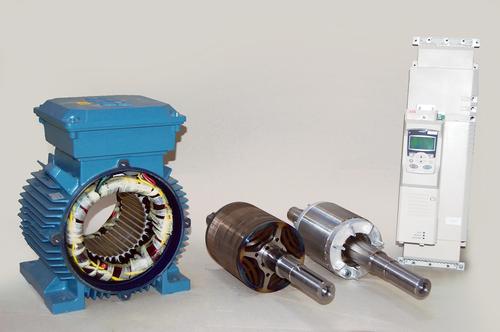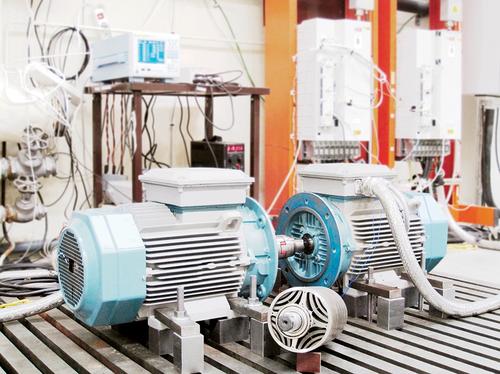March 11, 2015
Combining the advantages of permanent magnet and induction motors, new synchronous reluctance motors (SynRM) offer potentially breakthrough technology for variable speed drive (VSD) and motor packages. The new motors use an innovative rotor design that eliminates the slip losses associated with induction motors while offering the benefits of permanent magnet operation.
"The key trends in industry related to electric motors, and what customers and the marketplace value, are energy efficiency, size/footprint reduction, and reliability," says Panu Virolainen, head of research and development for ABB's Discrete Automation and Motion division.
"New synchronous reluctance motor-drive te
DN1.jpg
chnology offers benefits in precisely these three areas. It provides improved efficiency compared to standard induction motors, the ability to go to higher power density, and higher reliability that includes longer service intervals. The fundamental technology makes it possible to reach these benefits."
ABB recently unveiled two ranges based on these motors. One is designed to operate at the "super-premium" levels of efficiency likely to be defined in the IE4 specification. The other is optimized to deliver high output from a small frame.
Åke Andersson, technical manager at ABB, said the first super-premium efficiency motor-drive packages will be available in output power of 11-200kW (1,500-3,000rpm) and in IEC frame sizes of 160-315. A high-output range will offer packages up to 355kW (1,500-3,000rpm).
From a hardware perspective, the ACS850 drives offered as part of the packages are exactly the same as standard drives. The only change is support from a control algorithm perspective by adding the synchronous reluctance motors.
ABB has adapted its Direct Torque Control (DTC) algorithms to support SynRM motors to keep the drive current at a minimum value for each operating point while maximizing motor performance. The ACS850 drive with support for synchronous reluctance motors is in sequential introduction around the world, and it is offered seamlessly as a package with the SynRM motors.
"The super-premium efficiency of the package is very important, but the high-output package also has benefits for OEM or machinery builder customers," says Virolainen. "These compact solutions provide motor sizes that are dramatically smaller [up to two frame sizes] while providing the same power and torque."
To create a smaller, more efficient motor with a long lifetime and lower maintenance needs, as well as a new motor type that could be adapted to VSD operation, ABB says it considered all its technology options.
Starting a VSD motor is very different from a direct-line connection start, but this highlighted the opportunities to simplify the motor design and improve efficiency. Synchronous motors with a four-pole rotor operating at 50Hz rotate in synchronism with the supply at exactly 1,
DN2.jpg
500rpm. A corresponding induction motor has slip losses and rotates at only 1,475rpm (30kW). In modern induction motors with a short circuit rotor cage, the losses associated with the rotor amount to 20-35 percent of the total motor losses.
As a high-efficiency solution, synchronous reluctance motor technology is based on the concept of magnetic resistance or reluctance. The rotor is designed to produce the smallest possible reluctance in one direction and the highest reluctance in the perpendicular direction.
The motor produces torque as the rotor attempts to align the magnetically conducting direction to the stator field. What this means in practice is a new synchronous motor technology where the rotor is rotating at the same frequency as the stator field.
"On the rotor side of the motor, we are able to eliminate so-called slippage losses that exist in induction motors," Virolainen says. "These rotor-side losses are an essential part of the total losses of the motor, so eliminating them creates higher efficiency. We can reduce the losses by up to 40 percent, depending on the power rating of the motor, and increase the efficiency of the motor up to 5 percent in smaller power motors and 0.5 percent in the biggest frame motors, which puts us in compliance with the upcoming IE4 efficiency class in Europe."
Because of the lower losses on the rotor side, the design makes the SynRM motors smaller and lets them produce up to 40 percent more power at any motor size. These are the two main benefits of this technology.
Other benefits relate to reliability. The rotor construction itself is robust, and there is no squirrel cage or magnets on the rotor side. Thanks to the low losses, motor operating temperatures are also lower, which results in longer life for the insulation and bearings.
"If we compare the new motors to other synchronous permanent magnet motor technologies, there are no magnets and no risk of losing performance due to demagnetization from overheating or failure," Virolainen says. "There are no back EMF voltages caused by the spinning motor, which can be a safety concern, and, because of the synchronous rotation, the speed control is by nature accurate without needing additional encoders."
The core innovation is the rotor design, since the stator side of the motor is identical to an induction motor. ABB's knowledge and expertise helped it construct a robust, efficient rotor capable of high-speed operation. But drive technology and the matched motor-drive packages and drive algorithms make the system breakthrough possible from a technology perspective.
In many ways, synchronous reluctance technology combines the benefits of induction motors and permanent magnet motors. It provides the robustness of an induction motor and the size, efficiency, and synchronous speed operation benefits of permanent magnet motor technology while eliminating concerns related to permanent technology.
The primary benefits of the technology -- including size, efficiency, and reliability -- are generic and are applicable for a wide array of areas, but pumps, fans, and compressors are some of the mainstream applications. For example, the low-inertia rotor makes it possible to provide high-speed ramp rates that can be useful for cranes and hoists.
About the Author(s)
You May Also Like


